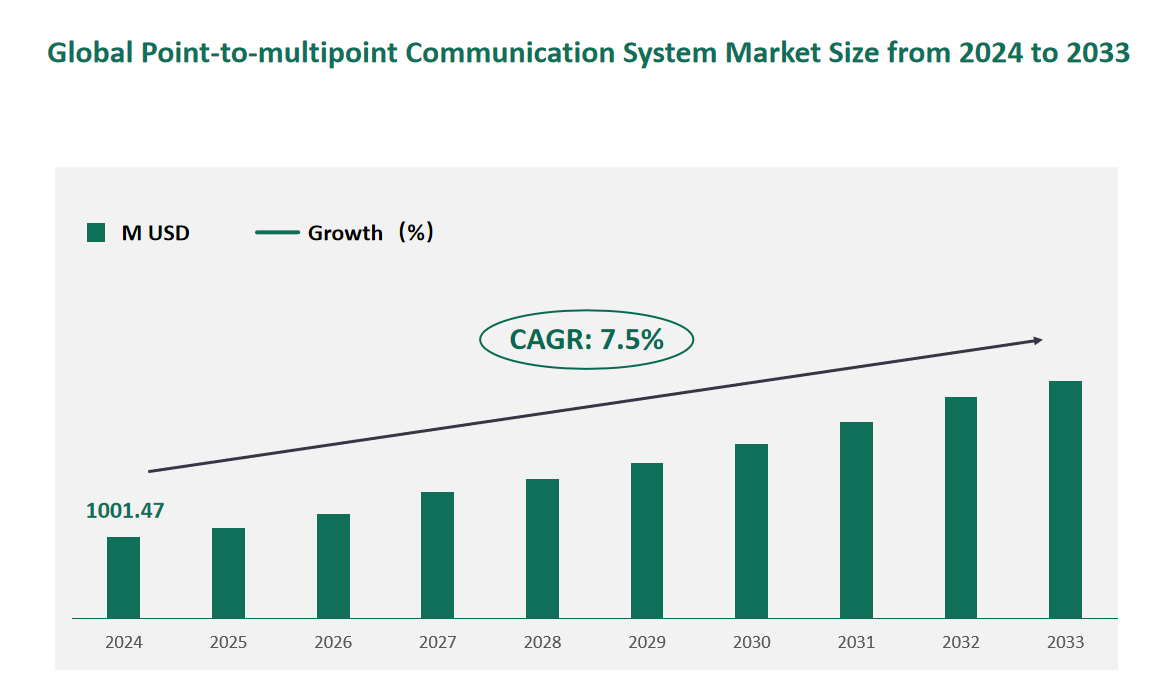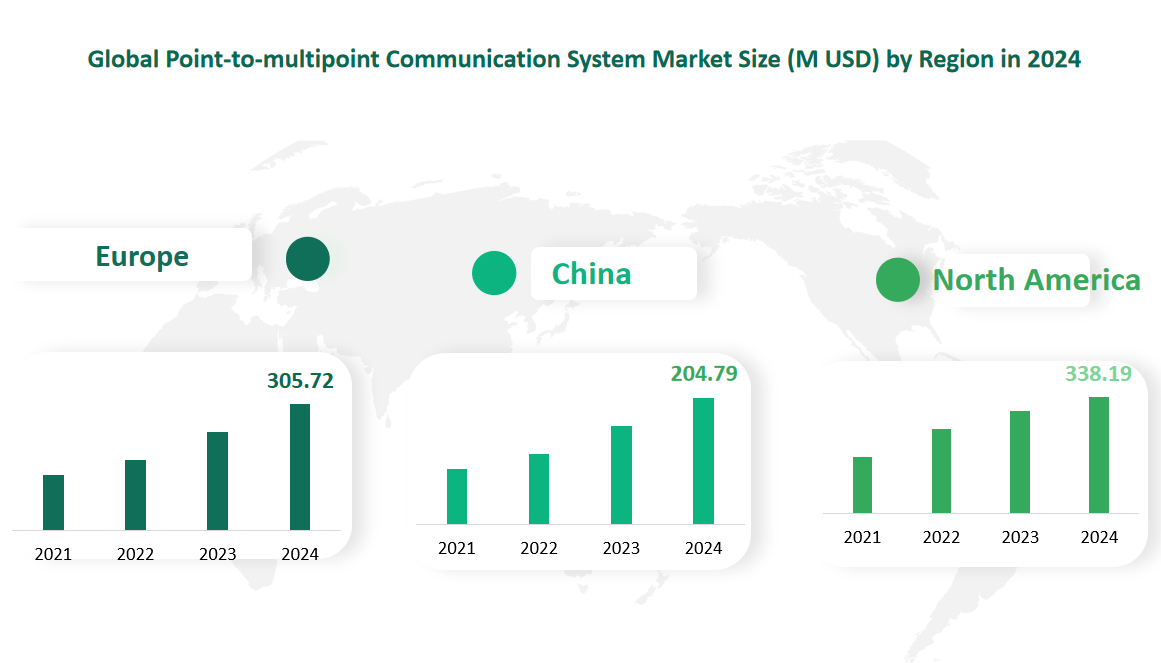1 Global Point-to-multipoint Communication System Market Size (Value) and CAGR (2024-2033)
In 2024, the global Point-to-multipoint Communication System market was valued at USD 1001.47 million, with a CAGR of 7.5% from 2024 to 2033.
In telecommunications, point-to-multipoint communication (P2MP, PTMP or PMP) is communication which is accomplished via a distinct type of one-to-many connection, providing multiple paths from a single location to multiple locations.
Figure Global Point-to-multipoint Communication System Market Size (M USD) and CAGR 2024-2033

2 Point-to-multipoint Communication System Market Drivers
The Point-to-Multipoint Communication System market has been experiencing significant growth, driven by several key factors. One of the primary drivers is the increasing demand for high-speed data transmission and connectivity. With the rapid expansion of mobile internet usage and the Internet of Things (IoT), there is a growing need for efficient and reliable communication systems that can support multiple users simultaneously. Point-to-multipoint (P2MP) systems offer a cost-effective solution for providing broadband access to multiple locations from a single base station, making them particularly attractive for both urban and rural areas.
Another significant driver is the deployment of 5G technology. 5G promises faster data speeds, lower latency, and the ability to support a large number of connected devices, which aligns perfectly with the capabilities of P2MP systems. The development and implementation of 5G networks are expected to boost the demand for P2MP solutions, as they can provide the necessary backhaul infrastructure for 5G services.
Government policies and regulatory support also play a crucial role in driving market growth. Governments around the world are allocating spectrum and implementing policies to encourage the development of advanced communication technologies. For example, the European 5G Observatory was established to monitor the progress of 5G connectivity objectives, while China has introduced various policies to promote the development of its information industry, including the deployment of 5G networks.
3 Point-to-multipoint Communication System Market Restraints
Despite the promising growth prospects, the Point-to-Multipoint Communication System market faces several challenges and restraints. One of the primary challenges is the threat of substitution. As new communication technologies emerge, there is a risk that P2MP systems could be replaced by more advanced or versatile solutions. For instance, the development of fiber-optic networks and other wired communication technologies could potentially limit the market for wireless P2MP systems.
Another significant challenge is the high initial investment required for deploying P2MP systems. The cost of equipment, installation, and maintenance can be prohibitive, especially for smaller operators and in less developed regions. This high cost can slow down the adoption rate of P2MP systems, particularly in emerging markets where financial resources may be limited.
4 Global Point-to-multipoint Communication System Market Size by Type in 2024
The Sub-8GHz segment is one of the most established and widely used types of Point-to-Multipoint Communication Systems. This frequency band is renowned for its robustness and ability to penetrate obstacles, making it particularly suitable for urban environments where line-of-sight (LOS) conditions may be challenging. In 2024, the market size for the Sub-8GHz segment is forecasted to reach $347.31 million. This segment is commonly used for wireless broadband access, cellular backhaul, and enterprise connectivity.
The 8GHz-26GHz band offers higher data rates and is ideal for applications requiring faster connectivity. This segment is projected to have a market size of $256.48 million in 2024. It is particularly popular in regions with a high demand for high-speed internet services and is used extensively by mobile network operators and internet service providers. The growth in this segment is fueled by the deployment of advanced wireless technologies and the need for higher bandwidth to support increasing data traffic.
The 26GHz-32GHz band is known for its high capacity and ability to support very high data rates. This segment is expected to reach a market size of $299.24 million in 2024. It is increasingly being adopted for applications such as 5G backhaul, where high-speed and low-latency connections are critical. The growth in this segment is driven by the expansion of 5G networks and the increasing demand for high-capacity communication systems that can support the next generation of wireless services.
The Above-32GHz segment represents the highest frequency band and is at the forefront of technological advancements. This segment is projected to have a market size of $98.44 million in 2024. It is used for cutting-edge applications such as millimeter-wave communication systems, which offer extremely high data rates and low latency. The growth in this segment is driven by the development of new technologies and the increasing demand for ultra-high-speed communication systems, particularly in the context of 5G and future wireless networks.
Table Global Point-to-multipoint Communication System Market Size by Type in 2024
Type | Market Size (M USD) 2024 |
Sub-8GHz | 347.31 |
8GHz-26GHz | 256.48 |
26GHz-32GHz | 299.24 |
Above-32GHz | 98.44 |
5 Global Point-to-multipoint Communication System Market Size by Application in 2024
In 2024, the market size for Mobile Network Operators is projected to reach $659.06 million, while the market size for Internet Service Providers is forecasted at $342.40 million. These segments play a crucial role in the overall market dynamics and growth prospects.
Mobile Network Operators (MNOs) are a significant end-use segment for Point-to-Multipoint Communication Systems. These systems are essential for providing high-speed data transmission and connectivity to mobile users. MNOs rely on P2MP systems for backhaul solutions, which enable the efficient transmission of data from cell towers to core networks. The growth in this segment is driven by the increasing demand for mobile data services, the expansion of 4G and 5G networks, and the need for reliable and high-capacity communication infrastructure. MNOs are constantly seeking to enhance their network capabilities to support the growing number of connected devices and the increasing data traffic generated by these devices.
Internet Service Providers (ISPs) also play a vital role in the Point-to-Multipoint Communication System market. ISPs use these systems to provide broadband internet access to residential and commercial customers. P2MP systems offer a cost-effective solution for delivering high-speed internet services, especially in areas where wired infrastructure is limited or not feasible. The growth in this segment is driven by the increasing demand for high-speed internet services, the expansion of smart cities, and the need for reliable and efficient communication systems to support various applications such as video streaming, online gaming, and remote work.
Table Global Point-to-multipoint Communication System Market Size by Application in 2024
Application | Market Size (M USD) 2024 |
Mobile Network Operators | 659.06 |
Internet Service Providers | 342.40 |
6 Global Point-to-multipoint Communication System Market Size by Region in 2024
North America, particularly the United States, is a leading market for Point-to-Multipoint Communication Systems, with a projected market size of $338.19 million in 2024. The region boasts a well-developed communication infrastructure and a high demand for high-speed data transmission and connectivity. The growth in this region is primarily driven by the rapid expansion of 5G networks, the increasing adoption of IoT devices, and the need for reliable and high-capacity communication systems. Companies like Cambium Networks and Huawei have a strong presence in this region, contributing significantly to market growth. The United States, in particular, has been at the forefront of technological innovation, with significant investments in research and development to enhance communication systems.
Europe is another significant market, with a projected size of $305.72 million in 2024. The region has a mature communication market, characterized by a strong focus on technological advancements and regulatory support. The European Union’s initiatives to promote digital infrastructure and the deployment of 5G networks are key drivers for market growth.
China is a rapidly growing market, with a projected size of $204.79 million in 2024. The country has been investing heavily in its communication infrastructure, driven by government policies aimed at promoting digitalization and the expansion of 5G networks. The growth in this region is also supported by the increasing demand for high-speed internet services and the need for efficient backhaul solutions to support the growing number of connected devices. Companies like Huawei and Comba Telecom have a strong presence in this market, contributing to its rapid development. China’s focus on technological innovation and infrastructure development has positioned it as a key player in the global Point-to-Multipoint Communication System market.
Figure Global Point-to-multipoint Communication System Market Size by Region in 2024

7 Major Players in Global Point-to-multipoint Communication System Market
7.1 Cambium Networks
Company Profile:
Cambium Networks is a leading provider of wireless broadband solutions, headquartered in the United States. The company specializes in point-to-point and point-to-multipoint platforms, offering robust solutions for video, VoIP, and data connectivity. Cambium Networks is recognized as a North American market leader and is known for its innovative and reliable products.
Business Overview:
Cambium Networks offers a wide range of products and services designed to meet the evolving needs of modern communication networks. Their solutions are used by mobile network operators, internet service providers, and enterprises worldwide. The company’s commitment to innovation and customer service has helped it maintain a strong market position.
Product Introduction:
One of Cambium Networks’ flagship products is the PMP 450m Access Point (AP) with cnMedusa Massive MU-MIMO technology. This advanced system enables network operators to provide high-speed internet connections with increased capacity and efficiency. The PMP 450m features an integrated 90° sector beamforming antenna array and a single cable connection, making it a powerful solution for modern networks.
Recent Financial Data:
In the most recent year, Cambium Networks reported a revenue of $39.84 million, with a gross margin of 43.76%.
7.2 Huawei
Company Profile:
Huawei is a global leader in information and communications technology (ICT), headquartered in China. The company offers a wide range of networking products and telecommunication solutions, including internet access, transmission networks, servers, storage, and security products. Huawei is known for its innovative solutions and strong market presence in Asia and beyond.
Business Overview:
Huawei’s business spans multiple sectors, including telecommunications, enterprise solutions, and consumer electronics. The company’s commitment to research and development has led to numerous technological breakthroughs, positioning it as a key player in the global ICT market. Huawei’s products and solutions are used by mobile network operators, internet service providers, and enterprises worldwide.
Product Introduction:
Huawei’s RTN510 is a Point-to-Multipoint (PMP) microwave system that operates in the unlicensed frequency band of 4.91 GHz to 5.97 GHz. This system is designed for LOS/Non-LOS transmission and flexible PMP networking, making it ideal for applications such as video surveillance, information site backhaul, and broadband coverage. The RTN510 is widely used in safe cities, oil and gas field monitoring, campus interconnection, and other critical applications.
Recent Financial Data:
In the most recent year, Huawei reported a revenue of $37.81 million USD for its Point-to-Multipoint Communication System business, with a gross margin of 41.13%.
7.3 Ceragon Networks Ltd
Company Profile:
Ceragon Networks Ltd, headquartered in the United States, is a leading provider of wireless communication backhaul services. The company specializes in WIMAX and LTE-ready solutions, serving a diverse range of clients, including fixed line and mobile operators, government agencies, utilities, and private-network service providers.
Business Overview:
Ceragon Networks is known for its innovative and reliable wireless backhaul solutions. The company’s products and services are designed to meet the stringent requirements of mission-critical networks. Ceragon Networks’ commitment to customer satisfaction and technological excellence has helped it maintain a strong market presence and a loyal customer base.
Product Introduction:
Ceragon Networks’ FibeAir IP-20C Assured is a versatile and compact all-outdoor wireless backhaul node. This system provides enhanced security features, including physical security, traffic encryption, anti-malware, identity management, centralized authentication, event logging, and secure product architecture. The FibeAir IP-20C Assured is designed to meet the demanding requirements of modern communication networks.
Recent Financial Data:
In 2018, Ceragon Networks Ltd reported a revenue of $29.99 million for its Point-to-Multipoint Communication System business, with a gross margin of 38.15%.

